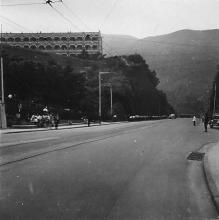Oriental Sugar Refinery [1876-c.1880]
Primary tabs
Opened in 1876, went out of business a few year later. The large chimney on the site survived for a few years until about c1890. Described as Jardine’s second sugar refinery in Hong Kong
In 1876 several Europeans financed by Chinese capital built the Oriental Sugar Refinery on property now defined by Swatow and Amoy Streets. It also soon failed and passed into receivership. Eventually it was taken over by Jardine, Matheson and Company and was merged with their China Sugar Refining plant at East Point
Source: Notes and Queries RASHK Vol 14 1974 p208
The Oriental Sugar Refinery Company of Hong Kong has been registered. It is proposed by the company to acquire the business of sugar refiners and dealers at present carried out by Messrs Smith, Frederick Dawson and Wahee, at Hong Kong. The capital is GBP 120,000, which is divided into GBP10 shares. The following gentlemen have signed the articles of Association: - J. B. Alliott, Bloomsgrove Works, Nottingham, fifty shares; J. W. Cordon, 54, Miller Street, Glasgow, fifty shares; J Beattie, 50, Buccleugh Street, Dumfries, fifty shares; F. G. Dawson, 108, Bishopsgate street Within, London, 10 shares; W. McGregor Smith, South Hackney, London, one share; J. Clewer, 27, Finsbury Place, 50 shares; J Fisher, 24, mark Lane, London, 10 shares
Source: The London and China Telegraph: 1877
The Oriental Sugar Refinery of Hong Kong is designed for the partial cleansing of raw sugar by the Weinrich patent centrifugal process. It is at present almost entirely employed in cleansing low sugars, which after preliminary treatment are completely refined at the China Sugar Refinery. It is capable of treating from 40 to 60 tons of sugar per day; the quantity operated upon being dependent on the quality
The Swatow Refinery at present being erected in similar design to the Oriental Refinery at Hong Kong. The machinery of both HOuses was manufactured by Messrs. Manlove, Alliott & Co, of Nottingham England
The Hong Kong refineries supply themselves with raw sugar not only from China, but also form the Philippines, COchin China,m the Straits Settlements and even from Java
The raw sugar is usually packed in mat bags, weighing about 1&½ picul each, and the refined in double matt bags of much superior quality, containing generally 1 picul each
Hong Kong, June 3rd 1880
Source: The Sugar Cane, Volume 12, 1st September 1880 p492.
A dispute over the ownership of the property in 1879 can be found in Chinese Middlemen in Hong Kong's Colonial Economy, 1830-1890 by Kaori Abe


Photos that show this place